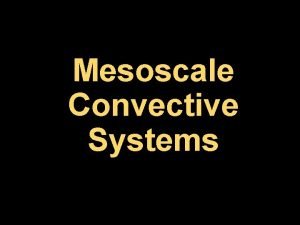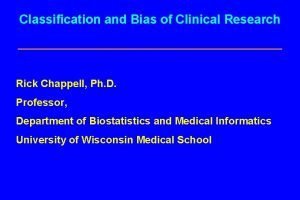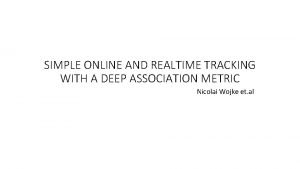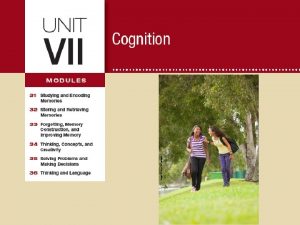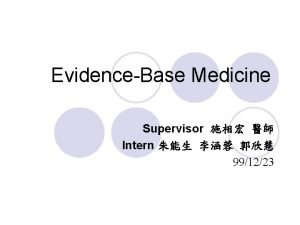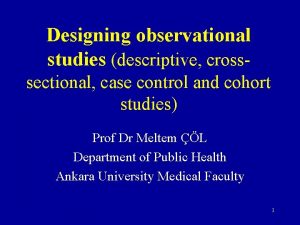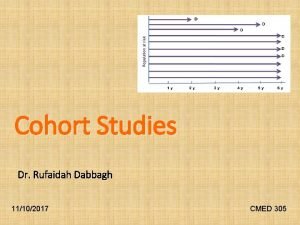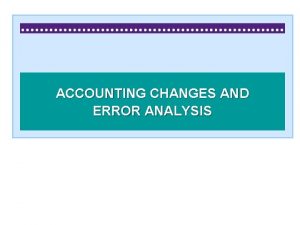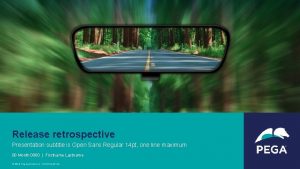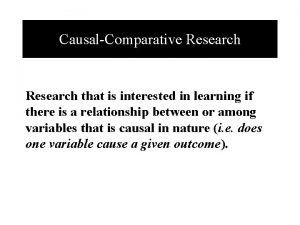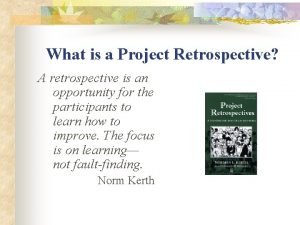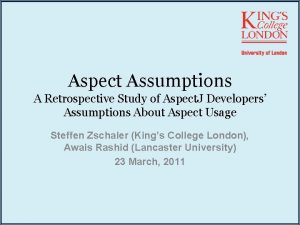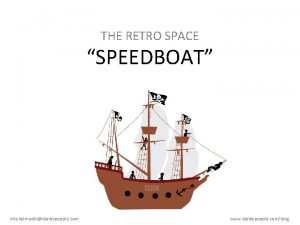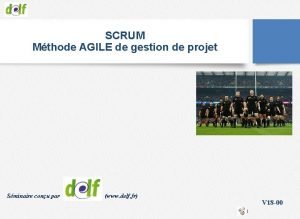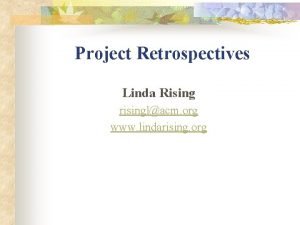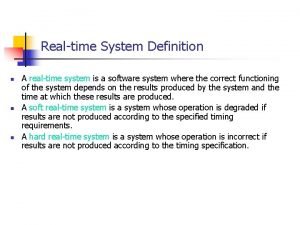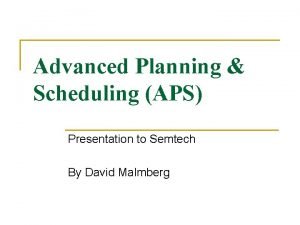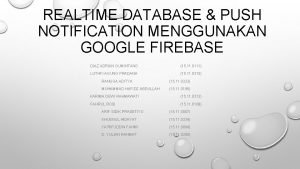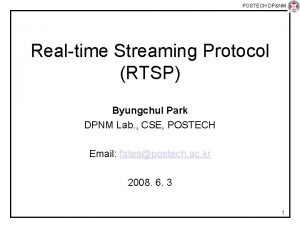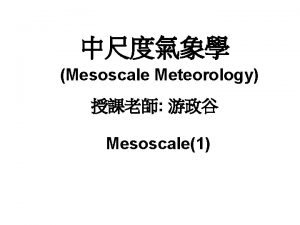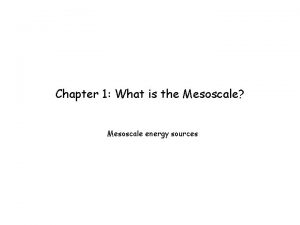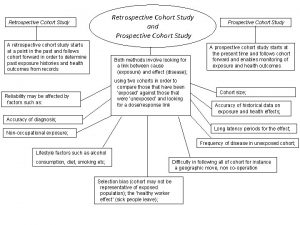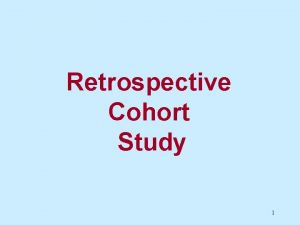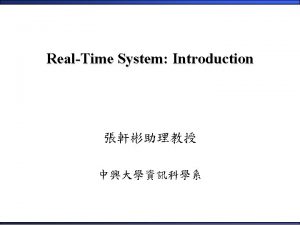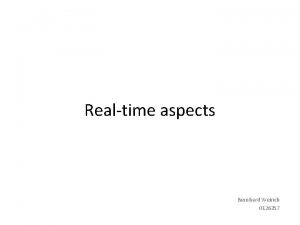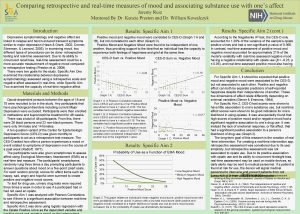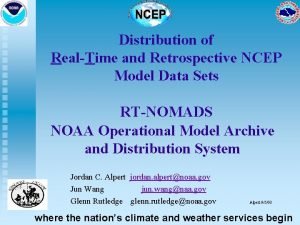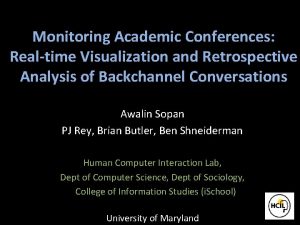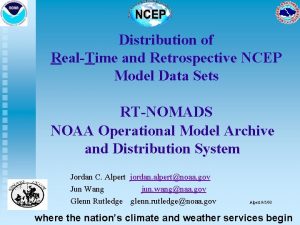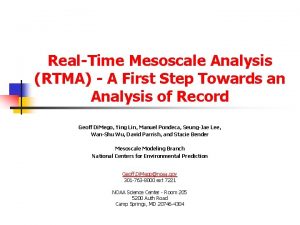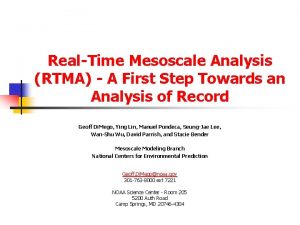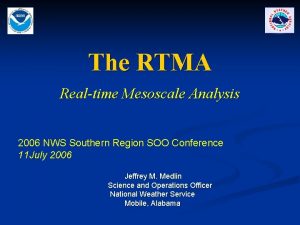A Community Meeting on Realtime and Retrospective Mesoscale


































- Slides: 34

A Community Meeting on Real-time and Retrospective Mesoscale Objective Analysis: An Analysis of Record Summit n n Can research and operations work together on this problem? Are there clearly definable requirements and objectives? Can we make a compelling argument? If so, to look beyond here – what next?

The First Step: Translating Needs to Requirements n n n Many applications require the current and past states of the atmosphere near the surface at high spatial and temporal resolution. What does an analysis of record represent? Can one analysis of record meet all needs? • • • Local analyses vs. national products Real-time vs. retrospective analyses Resolution issues n What spatial and temporal resolution? n Averages vs. extremes in time/space? • Parameter issues (temperature, precipitation, etc. )

The Second Step: Science, Technology, and Resource Inventory n To what extent can these requirements be met given existing scientific understanding, technologies, and resources? • What can be learned from the scientific literature and current applications? • What are the strengths and weaknesses of existing methodologies? • What observational data sets are most critical? • What limitations are imposed by the existing and future observational data assets vs. those available in the past? • What limitations are imposed by an underlying model? Sensitivity to boundary layer parameterizations, soil moisture, clouds, etc. ? • What are the realistic options for real-time and retrospective analyses within the next year or two? • Are there some aspects that are easier to accomplish than others? Real-time vs. retrospective? Specific variables (temperature vs. precipitation) • How can the quality of analyses be assessed? What are appropriate measures of skill?

The Third Step: Recommendations and Outcomes n n n What are the critical scientific issues that must be faced in order to successfully develop quality analyses at high spatial/temporal resolution? What additional R&D and resources are needed? Possible outcomes of this meeting? • USWRP report based on recommendations from workshop and additional feedback from operational, research, and user communities • Permanent NOAA/USWRP committee formed to continue advocacy for analysis of record • Propose fast-track implementation plan to provide AOR soon • Develop long-term clearly-defined project plan with compelling arguments • Propose funding opportunities and resources be sought to facilitate research projects from NWS, NSF, and other agencies • Advocate long-term funding from NOAA/NWS and other agencies for implementation of AOR beginning FY 07

Meeting Format n n n Overview talks (operations and research) Review talks from recent USWRP workshops Plenary sessions • • n Current capabilities Data specific applications Kalman Filter applications Future strategies (EMC, FSL) Breakout groups • • • Operational requirements Data and verification Assimilation strategies and techniques

Analysis of Record Issues: Operational Perspective Brad Colman NOAA/National Weather Service Seattle, Washington Brad. Colman@noaa. gov

Key questions n n n What is driving the current operational demand for a skillful, real-time mesoscale objective analysis? What are the specific requirements of a real-time effort to meet these demands? Where can science and/or analysis capabilities influence or help define specific forecast elements?

Your National Weather Service Goes Digital

National Digital Forecast Database (NDFD) n n n A national database of digital weather forecast information Designed to meet the fundamental weather information needs of industry, media, commercial weather services, academia, and public Includes multiple delivery formats, e. g. , via the web for user-selectable location specific forecasts or downloadable National data files

National Digital Forecast Database n n n Mosaic forecasts for the entire country or regional domains Public, marine and other products available Can be integrated with GIS mapping It’s aggressive and represents a major paradigm shift in the way field forecasters produce their forecasts.

Interactive Forecast Preparation System (IFPS) n Grid resolution (variable) • 5 km today, 2. 5 km being discussed within the next year (down to a “neighborhood” scale) • Basic building block for the weather element grids is 5 x 5 km spatial and 1 hour temporal n Numerical weather prediction inputs • Relatively coarse horizontal and vertical • “Smart. Init” process to downscale and generate sensible elements • Integration of point MOS guidance n Forecaster inputs and adjustments • • • Generally iterative (w/o fresh model data) Graphical editing tools “Smart. Tool” scripts

So, what is missing from this new forecast process? n n A forecast matching (or defining) analysis for: • Verification • A starting point for short-term forecasts • Resource management decisions Other operational applications: • Retrospective analyses and climate (25 years? ) • MOS and other post-processing techniques Analysis of Record!

Analysis of Record NWS motivation: Real-time seamless verification n Provide forecasters useful feedback n Give forecasters a way to assess the initialization and performance of NWP models n Serves as input to the GFE for use in shortterm forecasts n Contributes to the ongoing development of a gridded climatology n Building block for new MOS applications n Hydrology applications n

But, this is also a community problem • Mesoscale model development and verification • Transportation management • Emergency management and response • Hindcast testing of data assimilation schemes • Private sector requirements • Homeland defense • Regional climate studies • Etc.

Surface Transportation Weather Observational Requirements Paul A. Pisano Team Leader, Road Weather Management Federal Highway Administration

Surface Transportation Weather - Requirements The surface transportation forecast challenge: • Fine-scale models with the horizontal resolution of a transportation corridor (e. g. , an interstate highway) • More detailed forecast output in the Nowcast timeframe (0 -3 hr) • Update rates on the order of minutes • The ability to assimilate vast quantities of real-time mobile data • Specialized sub-processes that predict such roadway hazards as: • Precipitation start/stop times • Precipitation type and phase changes • Roadway icing (precipitation accumulation) • Roadway icing (frost deposition and black ice formation) • Reduced visibility in fog, precipitation or smoke • Driver level wind direction and speed • Driver level wind character (gustiness)

Key questions n n n What is driving the current operational demand for a skillful, real-time mesoscale objective analysis? What are the specific requirements of a real-time effort to meet these demands? Where can science and/or analysis capabilities influence or help define specific forecast elements?

Core parameters for Initial Operating Capability of NDFD n n n max/min temperature dew point relative humidity* max/min RH * heat index* wind chill* floating Po. P 12 prob of precip. (12 h)* sky cover wind direction and speed n n n n * Indicates a derived parameter wind gusts (>10 kts over sustained) 20 ft. wind * (NWS regional option) Lightning Activity Level (LAL) weather (type, intnsty, prob/covrg) snow amount significant wave height visibility

General Forecast Element Matrix The 0 -hour field is missing – we feel this should be an actual product

n n Considerations: • Be at the same resolution (both spatial and temporal) as the forecast grids • Incorporate data from all sources: RAWS, COOP, satellite, radar, lightning detection • Be as independent from the NWP models as possible Potential directions: • A collaborative effort will likely be needed between the NWS, ERL, private sector, and universities • Opportunities for outsourcing should be explored • External peer-review process will be beneficial • A long-term effort is required for optimal skill. But work should begin now on initial fast-track capability

Key questions n n n What is driving the current operational demand for a skillful, real-time mesoscale objective analysis? What are the specific requirements of a real-time effort to meet these demands? Where can science and/or analysis capabilities influence or help define specific forecast elements?

What do science and objective analysis techniques tell us about: n presenting a gridded forecast to users? • Grid-box average vs. grid-point? • expressing uncertainty within the grid box? n n deriving sensible weather elements from raw NWP output? weather elements that are uniquely defined by techniques and/or measurements? • • • Sky cover (METAR cig limitations, satellite, etc. ) Wind and wind gusts Maximum and minimum temperatures

AMS 1 st National Weather and Climate Enterprise Partnership Summit n n n Follows from NRC report “Fair Weather, Effective Partnerships in Weather and Climate Services. ” Part of AMS effort to serve as a neutral host 27/28 July 2004, Dallas-Fort Worth “Developing a National Mesoscale Observing Network: Fundamental Questions. ” Targets the process necessary to achieve a National mesoscale network

Critical Questions (1) (2) (3) (4) (5) What can be learned from the literature and applications of existing methodologies as far as benefits and limitations of a particular approach that may be advocated for an analysis of record? What are the critical issues that must be faced in order to successfully develop a quality analysis of record at spatial scales of 2. 5 -5 km every hour? Are there some aspects of an analysis of record effort that are more straightforward to accomplish than others, i. e. , specific variables (temperature vs. precipitation), real-time analyses vs. retrospective analyses? To what extent will the analysis of record be constrained by limitations of the existing and future observational data base vs. that available in the past? What observational data sets do we view to be most critical? To what extent will the analysis of record be constrained by limitations of an underlying model? Sensitivity to boundary layer parameterizations, soil moisture, clouds, etc. ? (6) What are appropriate measures to assess the skill of an analysis of record on these spatial and temporal scales? (7) What are the resource implications of a particular method?


EMC’s AOR Concept n n n Can’t just apply 2 -D analysis (variational or otherwise) to surface data - we might have 10, 000’s of mesonet/surface obs, B U T we have millions of AOR grid points Need a 3 -D forecast model to obtain temporally consistent solution dictated among observed data, terrain & lower boundary forcing and synoptic forcing Propose to apply tried & true NCEP 4 -D data assimilation technique of forecast-analysis cycle at high resolution (~2 km) with cost cutting measures to make feasible in production

EMC’s AOR Concept n n NCEP’s 4 DDA will (like the EDAS) use • Full complexity of NOAH Land-Surface Model • Assimilation of observed precipitation data to ensure lower-boundary states are optimal NCEP will use WRF-NMM as assimilating model to efficiently include • Nonhydrostatic effects in the dynamics • Terrain following coordinate (hybrid sigmapressure replaces step-mountain eta) • Nudging (not in any of NCEP current models)

EMC’s AOR Concept n n AOR’s emphasis is on sensible weather elements Focus AOR on surface & sensible weather where we have majority of mesoscale observations To save cost, reduce vertical resolution away from surface (run with 20 -30 levels instead of current 60 levels) To compensate for less vertical, nudge prediction away from sfc to an existing solution provided by operational North American Mesoscale run (currently 12 km Eta but 10 km WRF-NMM by late FY 2005)

Analysis of Record n n ISST has identified this as our number one priority Immediate goal: Determine operational requirements, science and R&D issues that need to be addressed, potential roadblocks, and strategy for implementation. Need to get this on a fast track!

National Digital Forecast Database targets a spectrum of weather information users The public, emergency managers and city planners use WWW. graphic products for detailed forecasts üMore weather data üHigher resolution forecasts Different Products for Different Customers Commercial weather companies & emergency managers use grids to generate tailored products üVisual displays of probability üUser-defined TODAY. . . RAIN LIKELY. SNOW LIKELY ABOVE 2500 FEET. SNOW ACCUMULATION BY LATE AFTERNOON 1 TO 2 INCHES ABOVE 2500 FEET. COLDER WITH HIGHS 35 TO 40. SOUTHEAST WIND 5 TO 10 MPH SHIFTING TO THE SOUTHWESTEARLY THIS AFTERNOON. CHANCE OF PRECIPITATION 70%. Radio stations & public read text forecasts products create business opportunities

New Forecasting Process National Centers • • • Model Guidance Grids Field Offices Local Digital Forecast Database Collaborate Interactive Collaborative Information Oriented National Centers Data and Science Focus NWS Automated Products LY. LIKEOVE B. RAIN LY A AY. . TODOW LIKE. SNOWBY SN 0 FEET ATION N 1 250 CUMULERNOOOVE AC E AFT ES AB DER LAT 2 INCH. COL TO 40. TO 0 FEETHS 35 D 5 250 H HIG ST WINTING WITUTHEAH SHIF SO 10 MP Y ARL TO THE STE N. TO UTHWE RNOO SO IS AFTEOF 0%. 7 TH ANCE ATION CH ECIPIT PR Digital Text Graphic Voice User-Generated Products National Digital Forecast Database

Traditional Forecasting Process • Schedule Driven • Product Oriented National Centers Model Guidance • Labor Intensive Field Offices National Centers Type Text Products Generate Graphical Products TODAY. . . RAIN LIKELY. SNOW LIKELY ABOVE 2500 FEET. SNOW ACCUMULATION BY LATE AFTERNOON 1 TO 2 INCHES ABOVE 2500 FEET. COLDER WITH HIGHS 35 TO 40. SOUTHEAST WIND 5 TO 10 MPH SHIFTING TO THE SOUTHWESTEARLY THIS AFTERNOON. MARYLAND EASTERN SHORE CHANCE OF PRECIPITATION 70%. EASTON PTCLDY CLOUDY PTCLDY SUNNY PTCLDY 60/52 63/54 65/47 55/40 55/37 50/33 POP 20 POP 10 » » » » » » » » » » » » » » » » » » » » » U. S. Drought Monitor Threats Assessments Excessive Heat Products

Taking Advantage of Technology Our Goal: To develop a new forecasting process and delivery system that will provide you with new and enhanced forecasts and multiple ways to receive NWS weather information

Surface Transportation Weather - Observations Better data sampling of the boundary Layer as a basis to resolve complex forecasting issues near the surface. New sampling technologies include (but are not limited to): • Differential GPS/Integrated Precipitable Water • RADNET “gap-filling, low-power” Phased Array Radars • Driver level visibility and road obscurations from new CCTV algorithms • Better freezing/frozen liquid equivalent observations from new sensor technologies (e. g. , new Hot-Plate Precipitation Sensors) • In-Vehicle sensors (air & road temperature, surface friction, precipitation rate, etc)
 Mesoscale definition
Mesoscale definition Retrospective labeling
Retrospective labeling Significant vs important
Significant vs important Retrospective studies pros and cons
Retrospective studies pros and cons What is meeting and types of meeting
What is meeting and types of meeting Types of meeting
Types of meeting Simple online and realtime tracking
Simple online and realtime tracking Cohort stidy
Cohort stidy Retrospective cohort study vs prospective cohort study
Retrospective cohort study vs prospective cohort study Retrospective memory
Retrospective memory Source amnesia
Source amnesia Retrospective goals in conflict
Retrospective goals in conflict Retrospective cohort vs case series
Retrospective cohort vs case series Retrospective cohort study vs case control
Retrospective cohort study vs case control Experimental research design types
Experimental research design types Retrospective cohort study
Retrospective cohort study Prospectively vs retrospectively accounting
Prospectively vs retrospectively accounting Ortere
Ortere Prospective causal-comparative research
Prospective causal-comparative research Project retrospective
Project retrospective Vendor rebate accrual
Vendor rebate accrual What is nature of risk
What is nature of risk Retrospective aspect
Retrospective aspect Speedboat retrospective
Speedboat retrospective Retrospective agile
Retrospective agile Retrospective validation
Retrospective validation Prospective validation
Prospective validation Norm kerth retrospective prime directive
Norm kerth retrospective prime directive For todays meeting
For todays meeting Proposal kickoff meeting agenda
Proposal kickoff meeting agenda Real time software definition
Real time software definition Gullistan carpet
Gullistan carpet Firebase realtime notification
Firebase realtime notification Realtime streaming protocol
Realtime streaming protocol Curis realtime
Curis realtime
